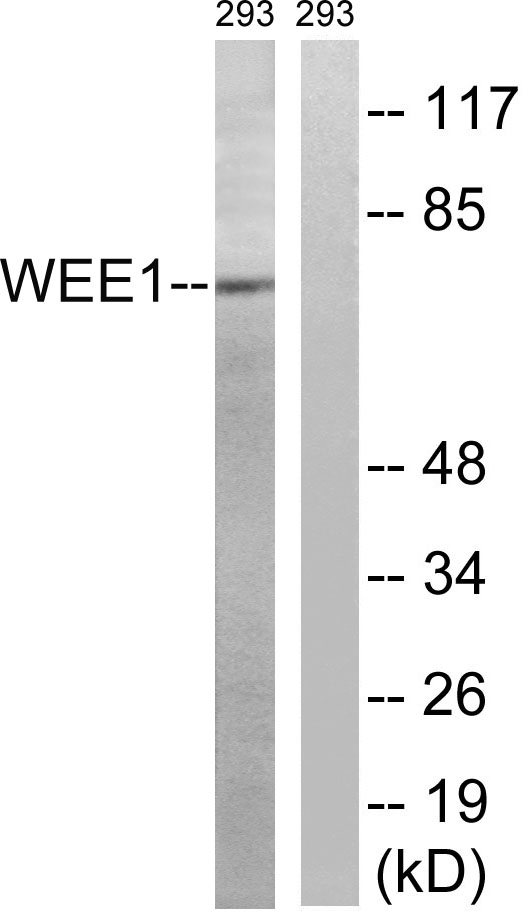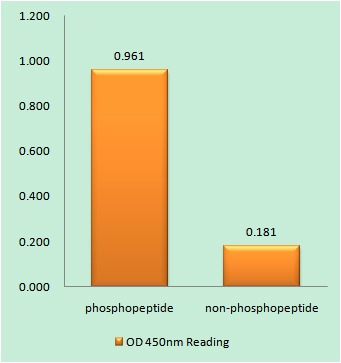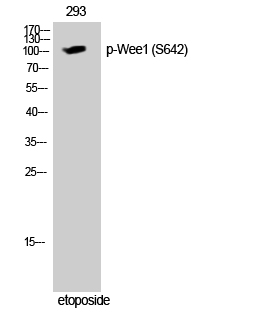
Catalog: YP1064
Size
Price
Status
Qty.
200μL
$600.00
In stock
0
100μL
$340.00
In stock
0
50μL
$190.00
In stock
0
Add to cart


Collected


Collect
Main Information
Target
WEE1
Host Species
Rabbit
Reactivity
Human, Mouse, Rat
Applications
IHC, IF, ELISA
MW
72kD (Calculated)
Conjugate/Modification
Phospho
Detailed Information
Recommended Dilution Ratio
IHC 1:100-1:300; ELISA 1:20000; IF 1:50-200
Formulation
Liquid in PBS containing 50% glycerol, 0.5% BSA and 0.02% sodium azide.
Specificity
Phospho-Wee 1 (S53) Polyclonal Antibody detects endogenous levels of Wee 1 protein only when phosphorylated at S53.The name of modified sites may be influenced by many factors, such as species (the modified site was not originally found in human samples) and the change of protein sequence (the previous protein sequence is incomplete, and the protein sequence may be prolonged with the development of protein sequencing technology). When naming, we will use the "numbers" in historical reference to keep the sites consistent with the reports. The antibody binds to the following modification sequence (lowercase letters are modification sites):EDsAF
Purification
The antibody was affinity-purified from rabbit antiserum by affinity-chromatography using epitope-specific immunogen.
Storage
-15°C to -25°C/1 year(Do not lower than -25°C)
Concentration
1 mg/ml
MW(Calculated)
72kD
Modification
Phospho
Clonality
Polyclonal
Isotype
IgG
Related Products
Antigen&Target Information
Immunogen:
The antiserum was produced against synthesized peptide derived from human WEE1 around the phosphorylation site of Ser53. AA range:19-68
show all
Specificity:
Phospho-Wee 1 (S53) Polyclonal Antibody detects endogenous levels of Wee 1 protein only when phosphorylated at S53.The name of modified sites may be influenced by many factors, such as species (the modified site was not originally found in human samples) and the change of protein sequence (the previous protein sequence is incomplete, and the protein sequence may be prolonged with the development of protein sequencing technology). When naming, we will use the "numbers" in historical reference to keep the sites consistent with the reports. The antibody binds to the following modification sequence (lowercase letters are modification sites):EDsAF
show all
Gene Name:
WEE1
show all
Protein Name:
Wee1-like protein kinase
show all
Other Name:
WEE1 ;
Wee1-like protein kinase ;
WEE1hu ;
Wee1A kinase
Wee1-like protein kinase ;
WEE1hu ;
Wee1A kinase
show all
Database Link:
Background:
WEE1 G2 checkpoint kinase(WEE1) Homo sapiens This gene encodes a nuclear protein, which is a tyrosine kinase belonging to the Ser/Thr family of protein kinases. This protein catalyzes the inhibitory tyrosine phosphorylation of CDC2/cyclin B kinase, and appears to coordinate the transition between DNA replication and mitosis by protecting the nucleus from cytoplasmically activated CDC2 kinase. [provided by RefSeq, Jul 2008],
show all
Function:
Catalytic activity:ATP + a [protein]-L-tyrosine = ADP + a [protein]-L-tyrosine phosphate.,cofactor:Binds 2 magnesium ions per subunit.,enzyme regulation:Synthesis is increased during S and G2 phases, presumably by an increase in transcription; activity is decreased by phosphorylation during m phase. Protein levels fall in M phase as a result of decreased synthesis combined with degradation. Activity seems to be negatively regulated by phosphorylation upon entry into mitosis, although N-terminal phosphorylation might also regulate the protein stability via protection from proteolysis or might regulate the subcellular location.,Function:May act as a negative regulator of entry into mitosis (G2 to M transition) by protecting the nucleus from cytoplasmically activated cyclin B1-complexed CDC2 before the onset of mitosis. Its activity increases during S and G2 phases and decreases at M phase when it is hyperphosphorylated. A correlated decrease in protein level occurs at M/G1 phase, probably due to its degradation. Specifically phosphorylates and inactivates cyclin B1-complexed CDC2 reaching a maximum during G2 phase and a minimum as cells enter M phase. Phosphorylation of cyclin B1-CDC2 occurs exclusively on 'Tyr-15' and phosphorylation of monomeric CDC2 does not occur.,PTM:Phosphorylated during M and G1 phases. Also autophosphorylated.,PTM:Ubiquitinated and degraded at the onset of G2/M phase.,similarity:Belongs to the protein kinase superfamily.,similarity:Belongs to the protein kinase superfamily. Ser/Thr protein kinase family. WEE1 subfamily.,similarity:Contains 1 protein kinase domain.,
show all
Cellular Localization:
Nucleus.
show all
Tissue Expression:
Amygdala,Blood,Epithelium,Human uterus endothel primary cell culture,Placenta,Skin,
show all
Research Areas:
>>Cell cycle ;
>>Human immunodeficiency virus 1 infection
>>Human immunodeficiency virus 1 infection
show all
Signaling Pathway
Reference Citation({{totalcount}})
Catalog: YP1064
Size
Price
Status
Qty.
200μL
$600.00
In stock
0
100μL
$340.00
In stock
0
50μL
$190.00
In stock
0
Add to cart


Collected


Collect
Recently Viewed Products
Clear allPRODUCTS
CUSTOMIZED
ABOUT US
Toggle night Mode
{{pinfoXq.title || ''}}
Catalog: {{pinfoXq.catalog || ''}}
Filter:
All
{{item.name}}
{{pinfo.title}}
-{{pinfo.catalog}}
Main Information
Target
{{pinfo.target}}
Reactivity
{{pinfo.react}}
Applications
{{pinfo.applicat}}
Conjugate/Modification
{{pinfo.coupling}}/{{pinfo.modific}}
MW (kDa)
{{pinfo.mwcalc}}
Host Species
{{pinfo.hostspec}}
Isotype
{{pinfo.isotype}}
Product {{index}}/{{pcount}}
Prev
Next
{{pvTitle}}
Scroll wheel zooms the picture
{{pvDescr}}


















